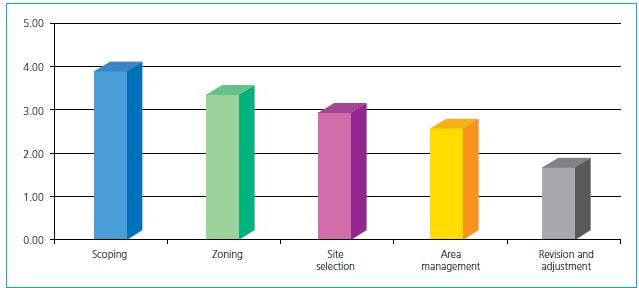Annex 5 Case Studies
Northern Ireland—were selected that represent partial or full implementation of aquaculture zoning, site selection and area management, covering different environments, species and farming systems.
The case studies from Oman and Uganda are good examples of scoping as an initial first step in spatial planning for aquaculture. Case studies on aquaculture zoning cover marine fish cages (Indonesia, Turkey), fish farming in cages in freshwater reservoirs and lakes (Brazil), and shrimp ponds in Mexico. Case studies on aquaculture management areas include: Chile, Hainan Island in China, the Philippines and the United Kingdom of Great Britain and Northern Ireland.
Each of the ten case studies presented in this paper describe, according to their national context, the main spatial planning and/or management processes as defined in this publication and expand on their ideal steps and processes.
To generate general recommendations, the workshop participants identified strengths and weaknesses of the spatial planning and area management processes by assessing the case studies performance against a set of main criteria (as appropriate under each step), such as: (i) promoting stakeholders participation; (ii) establishing agreed national/subnational priorities for aquaculture; (iii) enabling policy, legal and institutional frameworks; (iv) identifying main issues and opportunities; (v) conducting assessments of suitability for aquaculture; (vi) assessing risks to establish priority actions, location, maximum production, management measures, etc., including aspects of carrying capacity and biosecurity. Also included were (vii) the development of management plans; and (viii) some form of monitoring and evaluation of the management plans.
A matrix is presented at the end of each case study to summarize according to each phase/step, if the phase
Figure A5.1. Overall summary analysis of ten case studies.

Note: The average scores (0–5) according to the main spatial planning processes/steps are presented (i.e., 0 not achieved to 5 fully achieved).
step was either well done/achieved (briefly describing the main activities) or not done/not achieved (still pending). In addition, the matrix lists the associated/main activities and tools; a rating (0 not achieved to 5 fully achieved); and an approximate “incremental” investment needed for each step (United States dollars).
As a result of this exercise, it was concluded that scoping, as described in this paper, and aquaculture zoning and site selection are common processes in all the case studies, and in most cases steps (i) to (v) are followed. However, the establishment of aquaculture management areas (AMAs) with specific management plans is somewhat less common, and the criteria (vi) to (viii) are rarely considered (Figure A5.1).
According to the findings, the carrying capacity of an aquaculture site is rarely assessed. Some models and proxies are used, but in general there are no ecosystem response or long-term assessments. Management plans are often present for each site (in the case of large farms), but they are rare or less explicit for clusters of farms, aquaculture zones and AMAs. Monitoring and evaluation of management plans for AMAs are therefore rare or less implemented. However, in some areas, proposals for zoning and AMAs have already been initiated, such as in the aquaculture parks in Brazil and Uganda. Other countries like Indonesia, Mexico and Oman will need more time to report on their implementation.
The information described in the case studies and the feedback received from the authors of the case studies during a workshop in Turkey was used to improve and complete the spatial planning and management processes described in the main part of this publication.